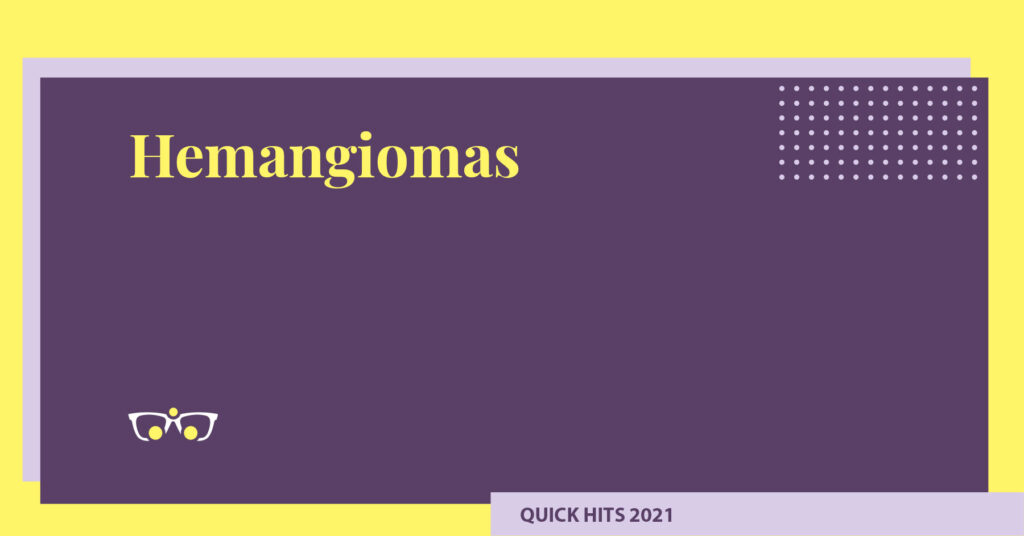- Benign:
- Epidermal inclusion cysts: from epidermal cells embedded in dermis (usually from trauma)
- are treated with excision
- Glomus tumor: benign hamartomatous neoplasm. most frequently in fingertip, subungually –> symptoms include pain, sensitivity to cold, tenderness on palpation, purple mass can sometimes be observed
- Love sign: extreme pain on direct focal pressure
- Hildreth sign: ablation of pain with proximal tourniquet inflation
- Ice bath immersion test
- MRI
- Treatment is complete excision
- Mucous cyst: ganglion cysts of the DIP joint associated with nail spurs and bony grooving
- Evaluation through physical exam and Xrays (xrays wil show DIP osteophytes)
- Nail grooving occurs through compression of germinal matrix
- Treatment: excise cyst and remove bony spurs
- Pyogenic granuloma: reactive vascular tumor that rapidly grows in response to minor trauma –> treatment is excision and cauterization of base, management can be chemical cauterization, currettage, silver nitrate
- Digital fibromatosis: rapidly growing broad base masses on dorsal/lateral aspects of finger
- Treatment is wide excision and FTSG
- Keratocanthoma: cutaneous lesion similar to SCC (benign), round, elevated, central crater. is variant of SCC, appears as red papule on sun damaged skin, rapidly expands
- excisional biopsy and primary closure
- Retinacular cysts: ganglion cysts of tendon sheath seen at volar MCP
- Ganglion cyst: most common hand tumor. volar wrist can arise from radiocarpal joint or capsule of scaphotrapezial joint (second most common), dorsal most common, (scapholunate ligament)
- Lowest recurrence rates with excision
- Other means such as aspiration or rupture
- Transilluminates
- Can observe pediatric ganglions if asymptomatic, most spontaneously rupture
- Observation warranted in pediatric ganlgions unless symptomatic
- Giant cell tumor: neoplasm of histiocytes,
- typically on tendon sheath, rubbery mass more common on flexor surface, slow growing, tan and typically multi lobulated. Can be invasive
- Hemosiderin deposits, risk of recurrence**
- Does not transilluminate
- needs complete excision
- (locally expansive tumors) that can metastasize to lung 1-5%
- Endochondroma: benign cartilaginous tumor in bone of hand; develop 2nd/3rd decade; pain in absence of fracture sign of malignant degeneration
- Show scalloped lytic lesion within medullary canal of affected bone with scattered calcification
- Hyaline cartilage surrounded by lamellar bone with varying calcification
- Associated with ollier’s disease (endochondromas with skeletal dysplasia); maffucci syndrome
- Mafucci syndrome: multiple endochondromas associated with vascular hemangioma
- Treat with curettage and bone grafting–> 10% will recur (most likely outcome is normal healing without recurrence)
- Can be autologous or bone graft substitute
- Most common location is proximal phalanx
- If incidental finding with fracture, treat fracture first then excise later
- Malignant degeneration into chondrosarcomas rare
- Chondromyxoid fibromas: benign cartilaginous tumors that rarely occur in upper extremity; radiolucent lesion with small sclerotic rims
- Osteoid osteomas: symptomatic, pain at night relieved with NSAIDS, xray shows target like lesion
- Hypervascular nidus of osteoblasts with surrounding cortical reactive bone formation
- Treatment is curretage and bone grafting
- Osteochondroma: have a bone stalk and cartilaginous cap growing from the metaphysis in skeletally immature patients
- Treat non operatively unless symptomatic
- Can occur with multiple hereditary exostosis (if other lesions are present)
- WLE and reconstruction to prevent symptoms (even if on the chest)
- Neurofibroma: tumor arising within the nerve fascicles.
- Evaluate with MRI
- Can cause deficits
- Think NF1 or vonrecklinghausen disease if have neurofibroma and café au lait spots
- Neurilemmoma (schwannoma): tumor of schwann (glial) cells on nerve surface
- Schwannoma: benign nerve tumor, painless, typically in proximal wrist; can be painful if in digits –> diagnose with tinel and MRI –> can perform marginal excision non infiltrative; on MRI is hyperintense on T2
- Usually does not affect nerve function
- NF2- associated with b/l acoustic schwannomas
- Pseudoaneurysms from arterial wall perforation treated with exploration and vascular repair (if arterial perfusion needed) otherwise can be excised
- AV malformations of hands: selective intralesional embolization followed by surgical resection
- Low flow malformations: like venous –> can be excised
- Present with soft, compressible, swelling with dependency, rapid growth with horomonal changes
- Sclerotherapy may be used for larger or more diffuse lesions
- Extensor brevis manus originates from DRC
- Can present as a tender dorsal wrist mass distal to the radiocarpal joint, can present as ganglion cyst, moves with finger movement
- Hemagiopericytoma: dervies from vascular zimmerman pericytes –> biopsy with wide local excision
- Lipoma is most common tumor on body, do not transilluminate and is mobile, slow growth, soft
- Gout:
- Tophi- present as red nodules with milky white fluid
- Treat with anti-inflammatory agents IE colchicine
- Malignant:
- SCC is the most common malignant tumor in the hand
- Malignant peripheral sheath tumors metastasize to lung (from nerve elements) and are the malignant form of neurofibroma
- They are classified as sarcomas
- Soft Tissue Sarcomas: rare tumors representing less than 1% malignancies
- Work up includes MRI, biopsy, and CT of chest
- Incisional biopsy through longitudinal incision for soft tissue masses after MRI, other things may spread
- For incisional biospy, longitudinal incision with tourniquet no esmarch
- Treatment includes wide excision, primary reconstruction, and radiation therapy
- Need at least a 1cm biopsy
- Transverse biopsies lend itself to higher recurrence rate in sarcomas and need for flap coverage
- Exsanguination of arm is not recommended in those with neoplastic tumors; can elevate and compress brachial artery; typically 250mmHg, 50-75 higher than SBP
- Osteosarcoma: most common location is the humerus, most common malignant tumor of bone
- Symptoms include pain and edema
- Radiographs reveal a sunburst pattern with periosteal elevation at codman’s triangle
- Epithelioid sarcoma: treatment is with pre-op radiation and WLE, chemotherapy if >10cm or high grade
- Remember preopreative radiation before WLE
- Verrucous carcinoma of fingernails from HPV, can mohs with graft coverage if DP not involved
- Suspect NF1 with malignant peripheral sheath tumors
Get Notified
Subscribe to our newsletter to receive the latest updates about our hosts and podcast.







